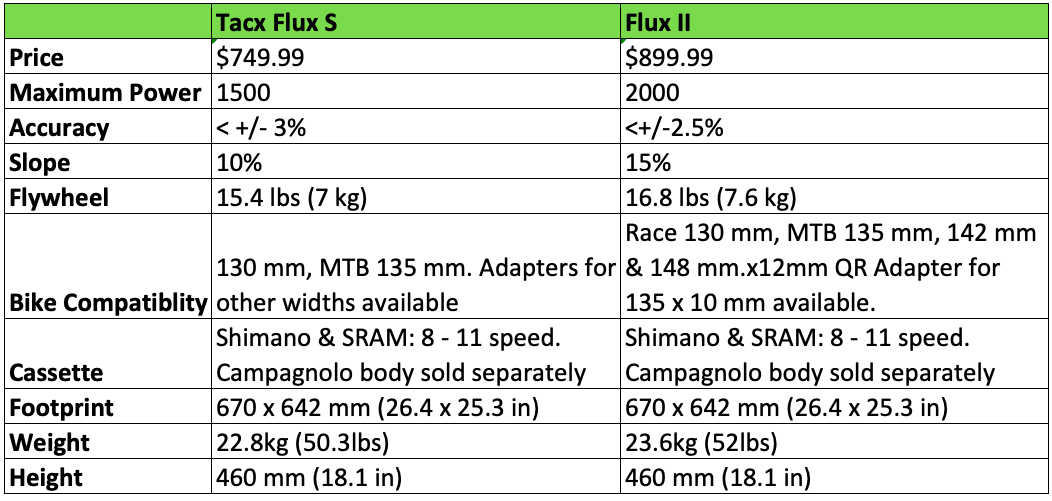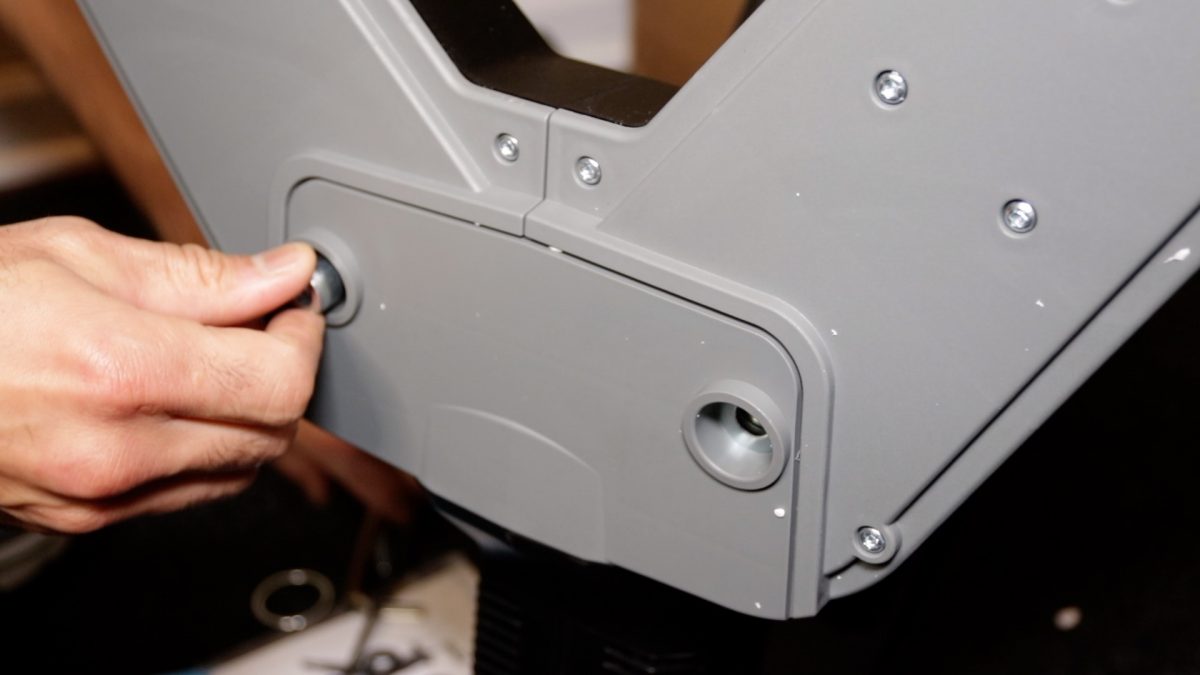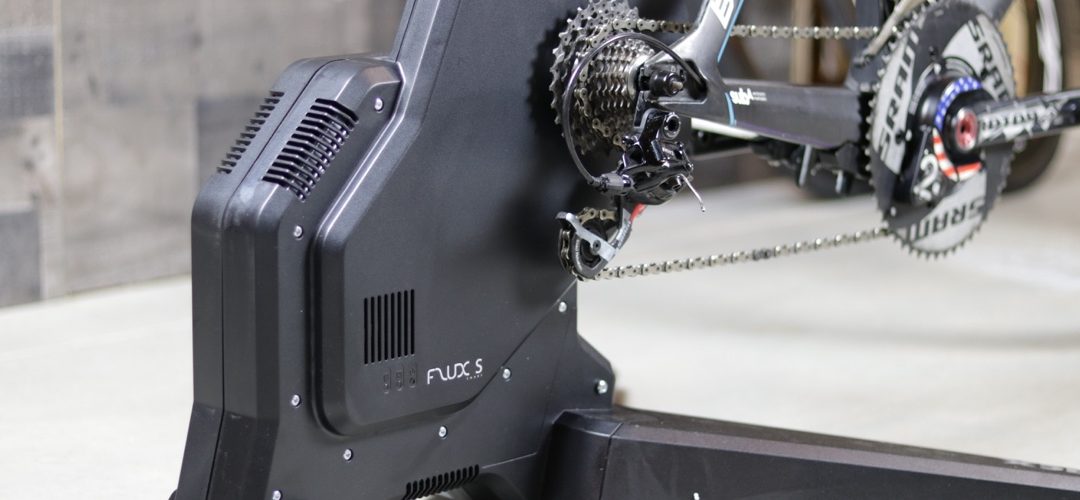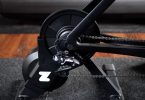PROS
- Price
- Accuracy
- Quick Response
CONS
- Requires some assembly
- High floor wattage
- Legs don’t fold
Tacx updated the Flux S last September with better internals and redesigned to improve power measurement, support for long cage derailleurs, and made it quieter than the original Flux.
Tacx sent me the Flux S for this review and I have been using it for the past couple of weeks. I put it through some Zwift racing, and ERG mode training. In this review, I will walk you through the Flux S and my findings and hope to help you with your purchase decision.
FLUX S SPECS
- PRICE: $750
- MAXIMUM POWER: 1,500 watts
- MAXIMUM SLOPE: 10%
- FLYWHEEL: 7 kg (15.4 lbs)
- ACCURACY: +/-3%
- BIKE COMPATIBILITY: 130 mm, MTB 135 mm. Adapters for other widths available.
- CASSETTE COMPATIBILITY: Shimano 9/10/11 speed, SRAM & Campagnolo 9/10/11 speed. As to the compatibility with Campagnolo, an adapter is required.
- CONNECTIONS: ANT+ FE-C compatible, Bluetooth, and Bluetooth FTMS.
- CALIBRATION REQUIRED: Yes.
- METRICS: Transmits power, speed, and cadence.
- APP COMPATIBILITY: The Flux S works with Zwift and TrainerRoad in Smart Bluetooth and ANT+ FEC.
VIDEO REVIEW
TACX FLUX S vs TACX FLUX II
Tacx also introduced the Tacx Flux II before they updated the original Flux with the Flux S. The Flux II offers a little more power, heavier flywheel, better accuracy, more slope support, and Tacx is including the 142mm & 148mm adapters with the Flux II. The Flux II will also cost you $150 more than the Flux S

ASSEMBLY & CALIBRATION
When you take the Flux S out of the box, you will find the trainer, power cord, manuals, and all the tools you need to put the legs together. The legs are simple to install and took me a few minutes to do.

Also, you need to provide your own cassette and install it. The Flux is compatible with 8-11 speed Shimano and SRAM. A Campagnolo is compatible but you will need to get an adapter.
You can purchase an 11-speed Shimano Ultegra cassette for about $65 but if you are still on a 10-speed cassette then you can save a few dollars and get a 10-speed Shimano Ultegra cassette for about $50. If you need a cassette plier, the Feedback Sports cassette plier and Cassette Wrench are one of my favorite and easy to use.
Once assembled, you should pair it to the Tacx utility app available for iOS and Android devices to check to see if there is a new firmware available. The firmware can be updated wirelessly using the Tacx utility app and you will be prompted to upgrade if there is a new version.
Once you ensure you have the latest firmware, you need to run the calibration to ensure the brake is set properly. The calibration can be done using the Tacx Utility app as well. Before you perform calibration, you should warm up the trainer for about 10 minutes. Once you perform the initial calibration, you should be all set for a while. With direct drive trainers, you will need to run the calibration once every 7 to 10 days or if you move the trainer around.
ROAD FEEL
The Flux has a 7 kg (14.7 lbs) flywheel which is heavier than other high-end trainers. But here is a perfect example of how bigger isn’t always better and looking at the number alone doesn’t give you a good indication of how the trainer feels. The Flux S road feel is good when comparing it to other mid-range trainers in its class but not as good as high-end trainers.
 The Flux is totally interactive and ANT+ FE-C, FTMS, and Smart Bluetooth compliant. It can interact with a multitude of apps, software, computers and devices (smartphones and tablets) with iOS, Android, OSX and Windows. It can be managed with Tacx Training or Tacx Utility app available for Android, iOS. It works with Zwift, TrainerRoad, Perfpro, The Sufferfest, and many other apps.
The Flux is totally interactive and ANT+ FE-C, FTMS, and Smart Bluetooth compliant. It can interact with a multitude of apps, software, computers and devices (smartphones and tablets) with iOS, Android, OSX and Windows. It can be managed with Tacx Training or Tacx Utility app available for Android, iOS. It works with Zwift, TrainerRoad, Perfpro, The Sufferfest, and many other apps.

NOISE
The Flux S is not that loud when cycling at lower speed. In my YouTube video review, I ran the Flux at 20mph and then at 30mph. The noise you hear at 20mph is what you will hear for most of the time. When in ERG mode, the flywheel speed will hardly go over 20mph and it will most likely be lower than that as long as you remain in the small front ring.
Even in sim mode, the flywheel itself will hardly spin that fast but as I do with all my noise demo videos, I like to run the trainer at the two different speeds just so you hear the noise level at both extremes.

ACCURACY
 Tacx claims +/- 3% accuracy, 1500 maximum watts, and 10% maximum slope for the Flux S. I collected a lot of data and compared them to my Power2Max and P1 pedals powermeters. The Flux came within range and in a lot of instances, it was just spot on.
Tacx claims +/- 3% accuracy, 1500 maximum watts, and 10% maximum slope for the Flux S. I collected a lot of data and compared them to my Power2Max and P1 pedals powermeters. The Flux came within range and in a lot of instances, it was just spot on.
Here is the chart from a Zwift race I did with the Flux. You can see how all three powermeters were together for the full ride except for the little section where my P1 pedals dropped signal. Seems to happen a lot more than I would like with the P1 pedals but that’s a whole different topic.
You will notice the Flux S was under-reporting but it was still within the -3% range. However, when hitting higher end watts, it was a little behind my other power meters and you will see that more in the graph below when in ERG mode.
ERG MODE
The below is a workout I did in ERG mode in Zwift. All three powermeters were on top of each other you kind of only see one color in the graph below and a little bit of red and green from time to time.

When hitting the initial 30-seconds intervals, the Flux S was under-reporting by about 20 watts or 6% off. Other than that, during the 10-minutes tempo intervals, it was right on target and you will see that in the table below. Here is the data from the workout. As you see, the Flux S almost matched my P1 pedals and power2max for each interval.
Here is the data from the workout. As you see, the Flux S almost matched my P1 pedals and power2max for each interval.

WATTAGE FLOOR
You might find it difficult with the Flux to reach your wattage floor, especially when in ERG mode. Here is a graph (source: TACX) explaining the lower end of watts the Flux can produce.
In this example, a 39 tooth front chainring and a 19 tooth rear cassette were used to help demonstrate what the Flux can produce.
For example, at a cadence of 75, you have an output of 100 Watt. If you want to go lower for this gear set, you need to change gears (go lighter to 21 teeth, up to 28 teeth). Alternatively, you will be required to reduce your cadence to ride lower than 100 Watts. The rest of the BLUE zone is the available braking power of the FLUX. With 75 RPM the FLUX can brake up to 400 Watt in the 39 – 19 setting. So, in this zone, you can ride a wide variety of training sessions.

CADENCE
The Flux does provide cadence data out of the box so no need to purchase a sperate cadence sensor. The Flux estimates cadence rather than measuring it directly from the source. You will see some spikes here and there but overall I thought it was good. As you see in the below chart, it matched my cadence sensor throughout the ride. If you are looking for accurate cadence measurement, then a dedicated cadence sensor is your best option. But the Flux S cadence measurement was very good and better than the original Flux. Also, if you use an Apple TV app such as Zwift or FulGaz, then you want to use the Flux cadence measurement to allow for an additional Bluetooth port for your heart rate monitor.

FINAL THOUGHTS
At $750, the Flux S is a very good entry level direct drive trainer. If you are looking to get into indoor training but don’t want to spend the money on a higher end trainer, the Flux S is a good option. It’s accurate, fully compatible with Zwift, Trainer Road, or any other indoor cycling application that supports ANT+ FE-C, FTMS, or Smart Bluetooth.
The Flux S legs don’t fold, so if space is an issue or you plan on traveling with your trainer, this can make it a little hard to do unless you take it apart.
The Flux S is available to order today and you can order it directly from Clever Training or Amazon.
-
Frame & Design
-
Ease Of Setup
-
Smart Connections & Compatibility
-
Accuracy
-
Responsiveness
-
Noise Level
-
Road Feel













Hi Tariq.
Very good review. Tnx!
I do experience some power drop-outs. It seems they happen in the higher watts and later in the workouts.
Any experiences like that?
Are you using ANT+ for connection? Most dropout problems happen usually when using ant+.
Have you noticed difference in wattage floor between resistance and erg mode? I read from TR forum someone experiencing such problems in erg mode while same low wattage was reached with same gearing in resistance mode. Or are those problems with trainer not following target in erg more related to kind of a user error?
The wattage floor is the same regardless if you are in ERG or sim mode. You just have to go to the lower ring to bring it down. It’s possible the user was switching gear in sim mode to bring down the resistance but didn’t in ERG mode. When in ERG mode, I found it best to leave it in the small front ring and mid to higher cassette in the back.
That is indeed the case – the floor is the same, ERG mode brings it down to minimum resistance and there is no difference between the 2 modes once you hit the floor. The resistance floor is indeed high, particularly if you naturally spin fast – a 39×19 will give you 150W at 95 rpm, not great for recoveries. I ended up swapping my old 7-sp freewheel (with 21T as the lowest gear) to a 10-sp setup and a 28T low gear, which solved the issue. But I still typically shift up (to mid-low in the cassette) for intervals, and back to lowest gear for recovery in Trainerroads. The issue is a lot less visible in Zwift, unless you do training programs there.